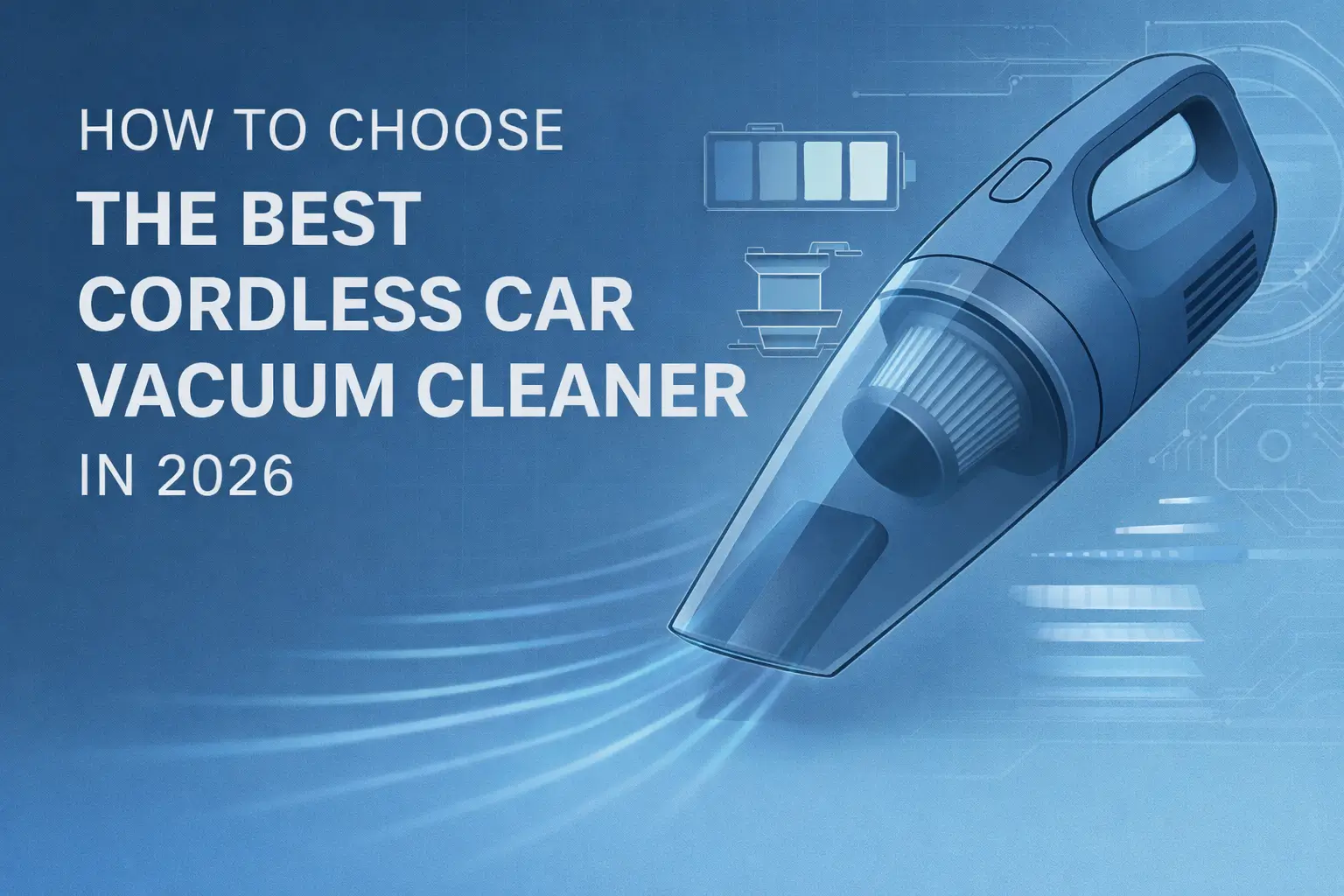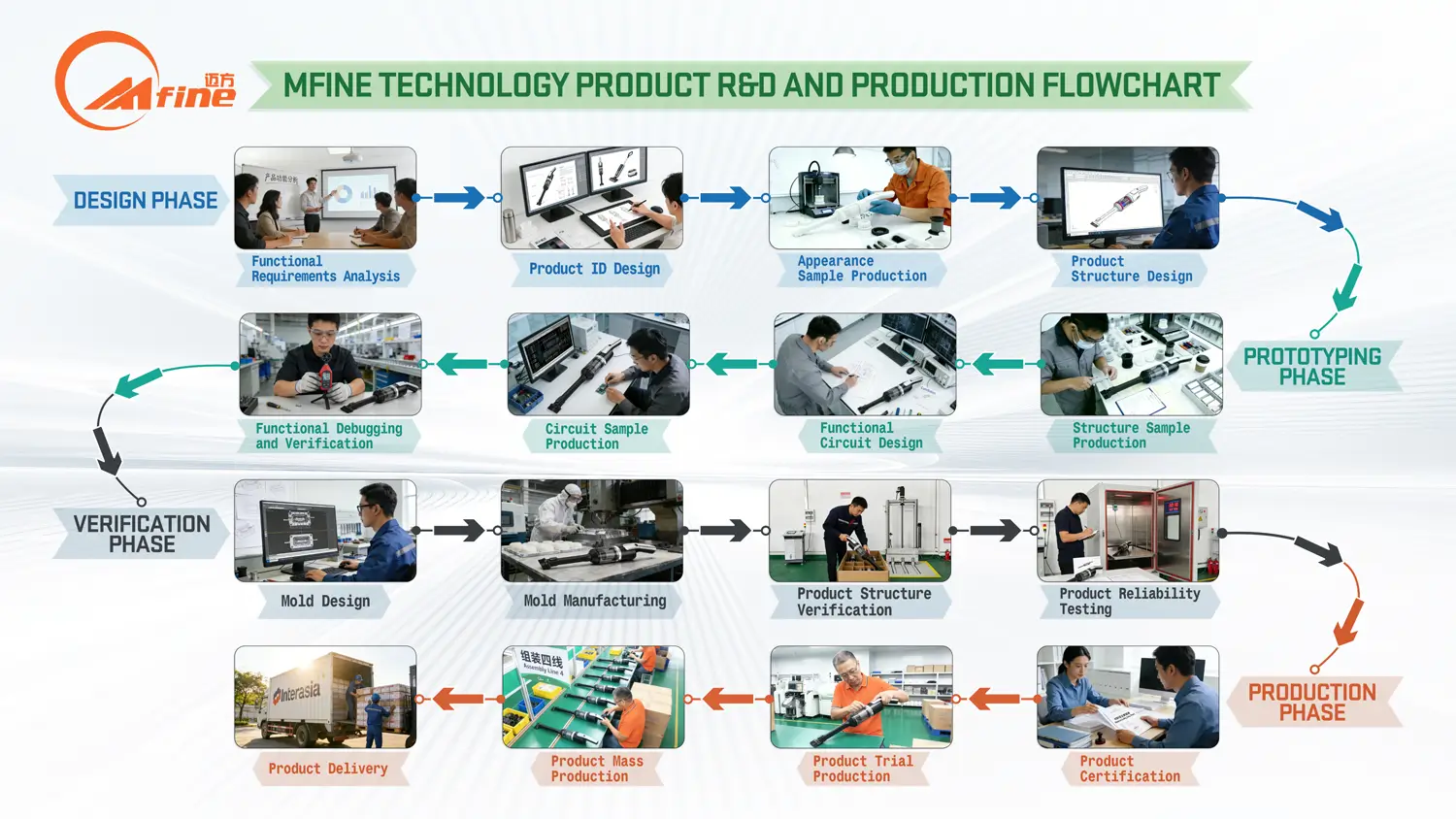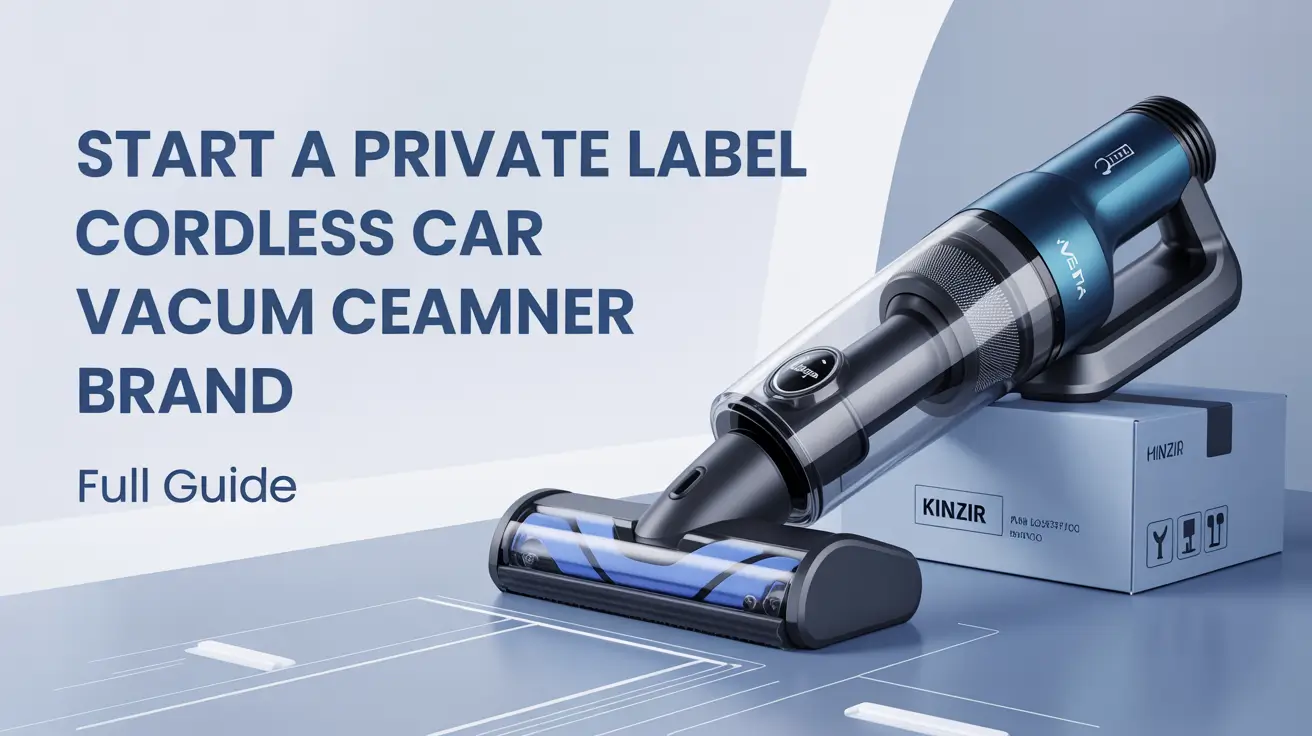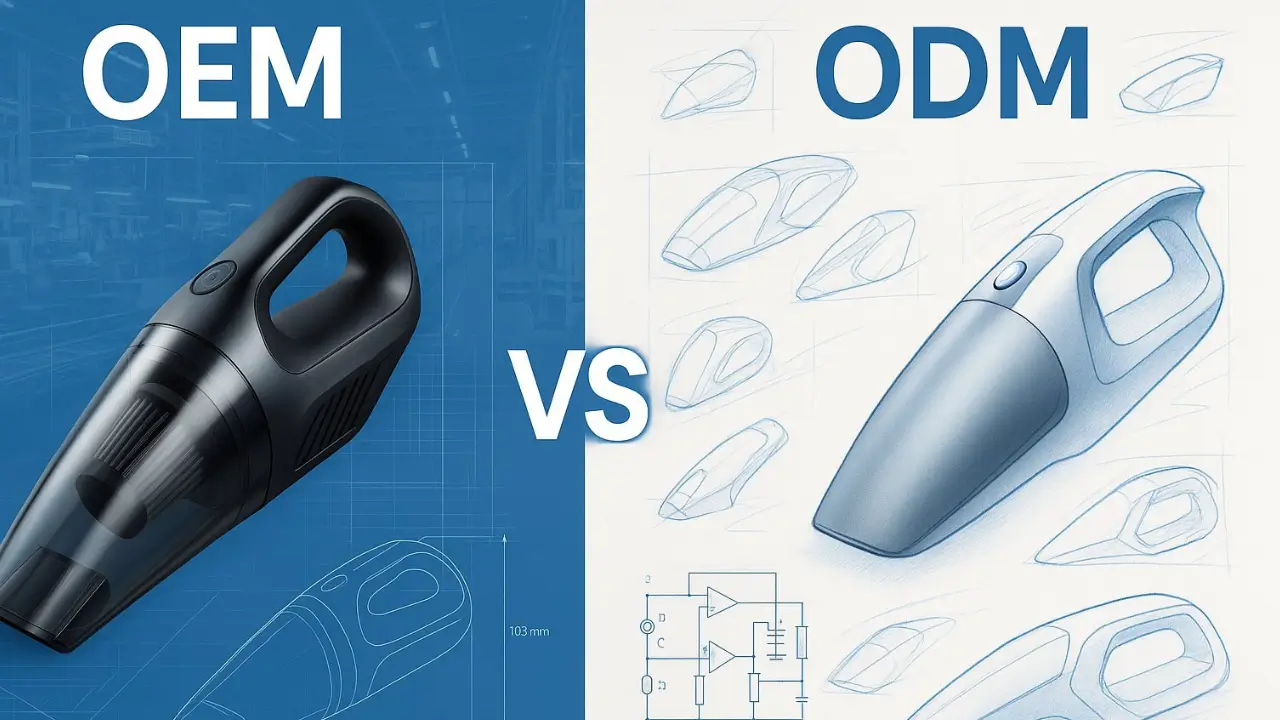RPM stands for revolutions per minute, and it measures how fast something spins in a complete circle. This measurement affects how well machines work and how much power they create.
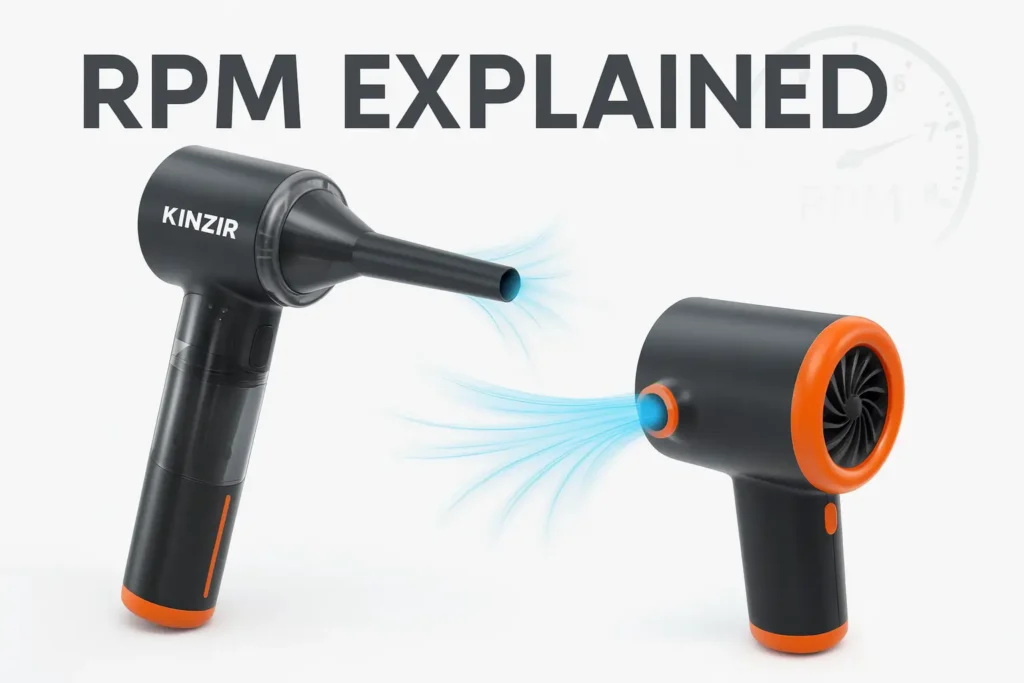
Higher RPM creates more centrifugal force, which helps vacuum cleaners pick up dirt better and helps fans move more air. When you understand RPM, you can pick better tools and know what to expect from them. Different machines need different RPM levels to work their best.
You will learn what makes a good RPM number and how companies like Kinzir use high-speed motors in their products. This guide covers everything from basic RPM facts to real examples of how it works in car vacuums and mini fans.
What Is RPM?
RPM stands for revolutions per minute and measures how many complete rotations an object makes in 60 seconds. This measurement helps you understand the speed and power of rotating devices.
Definition And Basic Formula
RPM measures rotational speed by counting full circles or revolutions. One revolution means a complete 360-degree turn around a central point.
The basic formula is simple: RPM = Number of Revolutions ÷ Time in Minutes
For example, if a motor shaft spins 3,000 times in one minute, it runs at 3,000 RPM. If it spins 1,500 times in 30 seconds, you calculate: 1,500 ÷ 0.5 = 3,000 RPM.
You can also convert from other time periods. If something rotates 50 times in 10 seconds, multiply by 6 to get RPM: 50 × 6 = 300 RPM.
Higher RPM numbers mean faster rotation. Lower numbers mean slower rotation.
Units Of Measure
RPM uses revolutions as the main unit. A revolution equals one complete circular motion or 360 degrees of rotation.
The time unit is always minutes. Some devices show RPS (revolutions per second), but RPM remains the standard measurement.
You might see these related terms:
- Hz (Hertz): Cycles per second
- Rad/s: Radians per second
- Degrees/minute: Degrees of rotation per minute
Most vacuum cleaners and fans display RPM because it shows performance clearly. Higher RPM typically means more suction power in vacuums and better airflow in fans.
Why RPM Matters
RPM directly affects how machines perform, from the power they produce to the noise they make. Different industries rely on specific RPM ranges to get the best results from their equipment.
Impact On Performance: Torque, Airflow, Noise
Power Output Changes With RPM
Your engine or motor produces different amounts of power at different RPM levels. Most engines have a sweet spot where they make the most power.
Car engines usually make peak power between 5,000 and 7,000 RPM. Below this range, you get less power. Above it, power often drops off.
Torque Varies Across RPM Range
Torque is the twisting force your engine makes. It changes as RPM goes up or down.
Diesel engines make high torque at low RPM. Gas engines often need higher RPM to reach peak torque. This affects how your vehicle accelerates and pulls loads.
Airflow Increases With Higher RPM
Fans and vacuum cleaners move more air at higher RPM. Double the RPM and you can get much more airflow.
A vacuum running at 20,000 RPM moves significantly more air than one at 10,000 RPM. This means better suction and cleaning power.
Noise Levels Rise With RPM
Higher RPM usually means more noise. The relationship is not always linear.
Some machines get much louder as RPM increases. Others stay relatively quiet until they reach very high speeds.
Examples Across Industries
Automotive Applications
Car engines operate between 600 and 8,000 RPM. Idle speed is around 600-900 RPM for smooth running.
Highway cruising happens around 2,000-3,000 RPM for fuel efficiency. Racing engines can reach 10,000 RPM or more for maximum power.
Power Tools and Appliances
Drill motors run from 300 to 2,000 RPM depending on the job. Lower speeds work better for screws and large holes.
Vacuum cleaners typically run between 15,000 and 35,000 RPM. Higher speeds create stronger suction for better cleaning.
Industrial Equipment
Manufacturing equipment uses precise RPM control for quality. Conveyor belts run at specific speeds to move products correctly.
Pumps and compressors need exact RPM to deliver the right pressure and flow rates.
How To Measure RPM
You can measure RPM using electronic devices like tachometers or by doing simple math calculations. Both methods give you accurate results for different situations.
Tachometers And Sensors
An RPM gauge or tachometer is the most common way to measure rotational speed. These devices use sensors to detect how fast something spins.
Digital tachometers work by pointing a laser or sensor at the rotating object. The sensor counts each rotation and shows the RPM on a display screen.
Contact tachometers touch the spinning part directly. You place the sensor tip against the shaft or rotating surface. The device measures the speed through direct contact.
Non-contact tachometers use light beams or magnetic sensors. You place a small reflective tape on the spinning object. The tachometer sensor detects each time the tape passes by.
Most car vacuum cleaners have built-in RPM sensors. These tachometer sensors help control motor speed automatically. The sensors send signals to adjust power based on the workload.
Manual Calculation Methods
You can calculate RPM without special tools using basic counting and timing methods. This RPM calculation method works well when you don’t have a tachometer.
Count the number of complete rotations in exactly 15 seconds. Multiply that number by 4 to get RPM. For example, if you count 25 rotations in 15 seconds, the RPM is 100.
Use a stopwatch for accurate timing. Mark one spot on the rotating object with tape or paint. This makes counting rotations easier and more precise.
For faster speeds, count rotations for 10 seconds and multiply by 6. This reduces counting errors when objects spin very quickly.
Write down your measurements and repeat the test three times. Take the average of your three results for better accuracy.
RPM In Electric Tools And Machines
Electric motors use RPM to control how fast tools work and how much power they deliver. You can adjust motor speed settings to match different jobs, but faster speeds often mean less twisting force.
Setting And Adjusting RPM In Motors, Fans, Drills
Most electric tools let you control RPM through built-in settings or variable speed triggers. Drills typically range from 300 to 1,500 RPM for different materials.
Common RPM ranges for electric tools:
- Hand drills: 300-1,500 RPM
- Angle grinders: 8,000-12,000 RPM
- Circular saws: 4,000-6,000 RPM
- Vacuum fans: 15,000-25,000 RPM
Brushless motors offer better RPM control than older brush motors. They maintain steady speeds under load and last longer.
OEM manufacturers design tools with specific RPM ranges for target applications. B2B buyers choose tools based on required RPM performance for their work tasks.
Motor performance testing measures actual RPM against rated specifications. Digital tachometers verify that motors reach advertised speeds during quality checks.
Trade-Off Between Speed And Torque
Higher RPM motors produce less torque at the shaft. This relationship affects how you choose tools for different jobs.
RPM vs Torque examples:
- High RPM, Low Torque: Fans, sanders, vacuum cleaners
- Low RPM, High Torque: Impact drivers, mixers, heavy drills
Motors deliver maximum power at specific RPM points. Running too fast or slow reduces efficiency and performance.
Vacuum cleaners need high RPM (15,000+ RPM) for strong suction but require less torque than drilling tools. Mini fans operate at similar speeds to move air effectively.
Variable speed controls help you find the right balance. Start slow for precision work, then increase RPM for faster material removal.
What Is A Good RPM?
Good RPM depends on what you need the device to do. Higher speeds create more airflow but use more power, while lower speeds offer better control and longer motor life.
Typical RPM Ranges By Product Type
Car vacuum cleaners typically run between 15,000 to 25,000 RPM. Basic models start around 15,000 RPM and work well for light cleaning tasks. Mid-range units operate at 18,000 to 20,000 RPM for regular car maintenance.
High-performance car vacuums reach 22,000 to 25,000 RPM. These speeds handle pet hair, sand, and deep carpet cleaning effectively.
Mini turbo jet fans operate at much higher speeds. Entry-level fans run at 30,000 to 40,000 RPM. Professional-grade units can reach 50,000 to 80,000 RPM or higher.
The rotational speed and torque trade-off becomes important at these levels. Higher RPM means less torque per revolution but greater overall airflow.
Selecting The Right Speed For Your Task
Match your RPM to your cleaning needs. Light dust removal requires 15,000 to 18,000 RPM. Regular car cleaning works best at 18,000 to 22,000 RPM.
Heavy-duty tasks need 22,000+ RPM. This includes wet spills, ground-in dirt, and thick carpets.
Airflow dynamics in compact motors affect performance differently than larger units. Smaller motors must spin faster to move the same amount of air. This is why mini fans operate at such high speeds.
Consider battery life when choosing speed settings. Higher RPM drains power faster but cleans more quickly. Lower speeds last longer but take more time to complete tasks.
Fixed Vs. Variable RPM
Fixed RPM devices run at one constant speed, while variable RPM systems let you adjust the motor speed based on your needs. Variable speed control offers better energy savings and can reduce wear on motor parts.
Benefits Of Adjustable-Speed Control
Variable rpm control gives you flexibility that fixed-speed motors cannot match. You can set lower speeds for light cleaning tasks and higher speeds for tough jobs.
This control helps you match the motor power to what you actually need. Running at lower speeds when possible saves energy and creates less noise.
Key advantages include:
- Better battery life in cordless devices
- Quieter operation at lower speeds
- More precise suction control
- Extended motor lifespan
Variable-speed drives also perform better in different conditions. Hot weather or dusty areas might need different power levels than normal use.
You get more value from one device instead of buying multiple tools for different tasks. The motor adapts to your cleaning needs rather than forcing you to work around one fixed speed.
Energy Use And Wear Considerations
Fixed-speed motors use the same amount of power whether you need full suction or not. This wastes energy during light cleaning tasks.
Variable RPM systems use less electricity at lower speeds. The motor draws power based on the speed you select, not its maximum capacity.
Energy efficiency differences:
- Fixed RPM: Constant high power draw
- Variable RPM: Power matches selected speed
Motor wear also changes between these systems. Fixed motors run at full speed constantly, creating steady stress on all parts.
Variable speed motors experience less wear when running slower. The bearings, brushes, and other moving parts last longer with reduced constant strain.
Heat buildup decreases at lower RPMs too. Less heat means better protection for motor windings and electronic components inside the device.
RPM In Action: Kinzir Case Study
Kinzir’s VC44 2-in-1 Cordless Car Vacuum Cleaner runs at 90,000 RPM while their AD47 Mini Turbo Jet Fan Blower reaches 100,000 RPM. These speeds deliver the strong suction and airflow you need for cleaning tasks.
Car Vacuum Cleaner: 90,000 RPM For Deep-Reach Suction
The Kinzir VC44 2-in-1 Cordless Car Vacuum Cleaner operates at 90,000 RPM. This high rpm vacuum cleaner creates strong suction power that pulls dirt from deep carpet fibers and tight spaces.
At this speed, the motor spins fast enough to move large amounts of air through the vacuum. More air movement means better suction power for your cleaning tasks.
The 90,000 RPM creates enough force to lift pet hair, crumbs, and dust particles from car seats and floor mats. You get consistent cleaning power whether you’re working on fabric or hard surfaces.
This car vacuum rpm case study shows how the high-speed motor makes the difference between weak suction and professional-level cleaning results.
Mini Turbo Jet Fan: 100,000 RPM For Powerful Air Thrust
The Kinzir AD47 Mini Turbo Jet Fan Blower reaches 100,000 RPM. This mini turbo jet fan rpm creates strong airflow that pushes debris out of hard-to-reach areas.
At 100,000 RPM, the fan blades move air at high velocity. This speed generates enough force to blow leaves, dust, and small debris away from surfaces.
The high RPM lets you clear gutters, blow out car vents, and remove debris from outdoor equipment. You get concentrated airflow that works faster than lower-speed alternatives.
This speed also helps with drying tasks after washing your car or cleaning outdoor surfaces.
How Kinzir Optimizes Motor, Blade Design, And Housing For Peak Performance
Kinzir uses brushless motors to reach these high RPM levels. Brushless designs create less friction and heat, letting the motor spin faster while lasting longer.
The blade design matches each product’s purpose. The vacuum uses impeller blades that pull air inward. The fan uses propeller-style blades that push air outward with maximum force.
Housing materials reduce vibration at high speeds. Strong plastic and metal components keep the units stable when running at 90,000 to 100,000 RPM.
Air intake and exhaust paths are designed to reduce turbulence. Smooth airflow paths let the motors work more efficiently at peak RPM levels.
These design choices work together to deliver the performance you expect from high-speed cleaning tools.
Conclusion
RPM directly affects how well your vacuum or fan works. Higher RPM numbers usually mean better suction and airflow for most cleaning tasks.
Key Takeaways
RPM measures how fast a motor spins each minute. Car vacuums with higher RPM create stronger suction power.
Most good car vacuums run between 20,000 to 30,000 RPM. Mini turbo jet fans often reach 40,000 RPM or more.
Higher RPM benefits:
- Stronger suction for deep cleaning
- Better pickup of pet hair and debris
- Faster cleaning times
- More effective on carpets and upholstery
The motor type affects RPM performance. Brushless motors maintain steady RPM under load. They also last longer than brushed motors.
Why RPM Specs Matter When You Choose A Motor Or Tool
RPM specs help you compare different models. A vacuum with 25,000 RPM will outperform one with 15,000 RPM for most jobs.
Check the sustained RPM rating. Some motors lose speed when working hard. Look for motors that keep high RPM even with heavy debris.
Consider your cleaning needs. Light dust requires less RPM than ground-in dirt. Car detailing needs higher RPM for thorough results.
RPM ranges for different tasks:
- Light cleaning: 15,000-20,000 RPM
- Regular car cleaning: 20,000-25,000 RPM
- Heavy-duty detailing: 25,000+ RPM
Battery voltage affects RPM too. Higher voltage batteries maintain RPM longer during use.
Frequently Asked Questions
RPM affects performance, efficiency, and power output in different ways across various applications. Understanding these relationships helps you make better decisions about engine operation and equipment selection.
Is higher RPM always better?
Higher RPM is not always better. It depends on what you need from your engine or motor.
For car engines, higher RPM gives more power but uses more fuel. Your engine also wears out faster when it runs at high RPM for long periods.
For vacuum cleaners and fans, higher RPM usually means better suction or airflow. But it also creates more noise and uses more energy.
The best RPM range depends on your specific needs and the equipment you are using.
How RPM relates to noise and airflow?
Higher RPM creates more noise in most motors and engines. The faster parts move, the more sound they make.
Airflow increases with RPM in fans and vacuum cleaners. When the motor spins faster, it moves more air through the system.
You often have to balance noise levels with performance. Higher airflow comes with higher noise in most cases.
Some motors are designed to run quieter at high RPM, but they still make more noise than when running slower.
What does RPM stand for in automotive context and how does it impact engine performance?
RPM stands for revolutions per minute in cars. It measures how many times your engine’s crankshaft spins in one minute.
Higher RPM means your engine produces more power and torque. This gives you better acceleration and performance.
Your car’s tachometer shows engine RPM. Most car engines work best between 1,500 and 4,000 RPM for daily driving.
Racing engines can reach 8,000 to 10,000 RPM or higher for maximum power output.
How do Kinzir Car Vacuum Cleaners benefit from high RPM motors?
Kinzir car vacuum cleaners use high RPM motors to create strong suction power. The faster motor speed pulls dirt and debris more effectively from car surfaces.
High RPM motors in these vacuums can remove pet hair, crumbs, and small particles that lower-speed motors miss. The increased spinning speed creates better airflow through the vacuum system.
These motors also work faster, so you spend less time cleaning your car interior. The high-speed operation makes the cleaning process more efficient.
At what RPM range should a typical car operate for optimal efficiency?
Most cars run most efficiently between 1,500 and 2,500 RPM during normal driving. This range gives you good fuel economy while providing enough power.
Highway driving usually keeps your engine between 2,000 and 3,000 RPM. City driving often stays below 2,500 RPM for better fuel savings.
Going above 3,500 RPM regularly increases fuel use and engine wear. Staying below 1,200 RPM can cause engine problems and poor performance.
How is RPM related to the acceleration and speed of a vehicle?
Higher RPM gives you faster acceleration because your engine produces more power. When you press the gas pedal, RPM increases and your car speeds up quicker.
Your transmission changes gears to keep RPM in the right range as your speed increases. Each gear lets you reach higher speeds at similar RPM levels.
Peak power usually happens at higher RPM ranges. This is why your car accelerates best when the engine revs higher.
What are the effects of RPM on a car’s fuel consumption and engine wear?
Higher RPM increases fuel consumption because your engine burns more gas per minute. Running at 4,000 RPM uses much more fuel than running at 2,000 RPM.
Engine wear also increases with higher RPM. Parts move faster and create more friction and heat inside your engine.
Keeping RPM in the 1,500 to 2,500 range saves fuel and reduces wear. Short periods of higher RPM for passing or merging are normal and acceptable.
In terms of RPM, how do Mini Turbo Jet Fans enhance airflow for cooling or other applications?
Mini Turbo Jet Fans operate at very high RPM to move large amounts of air quickly. These high speeds create powerful airflow for cooling electronics or small spaces.
The turbo design lets these fans spin faster than regular fans while staying compact. Higher RPM means more air movement per minute through the fan blades.
These fans can reach RPM levels much higher than standard cooling fans. The increased speed makes them effective for applications that need strong airflow in small areas.

